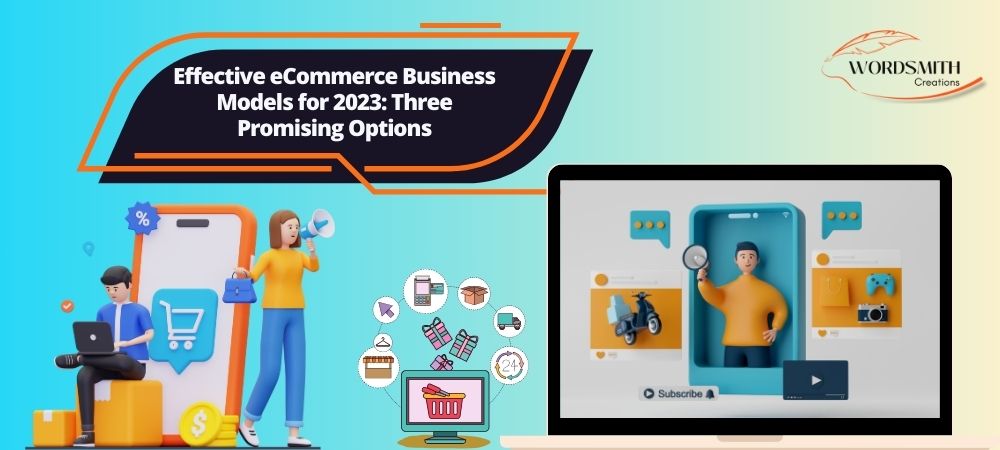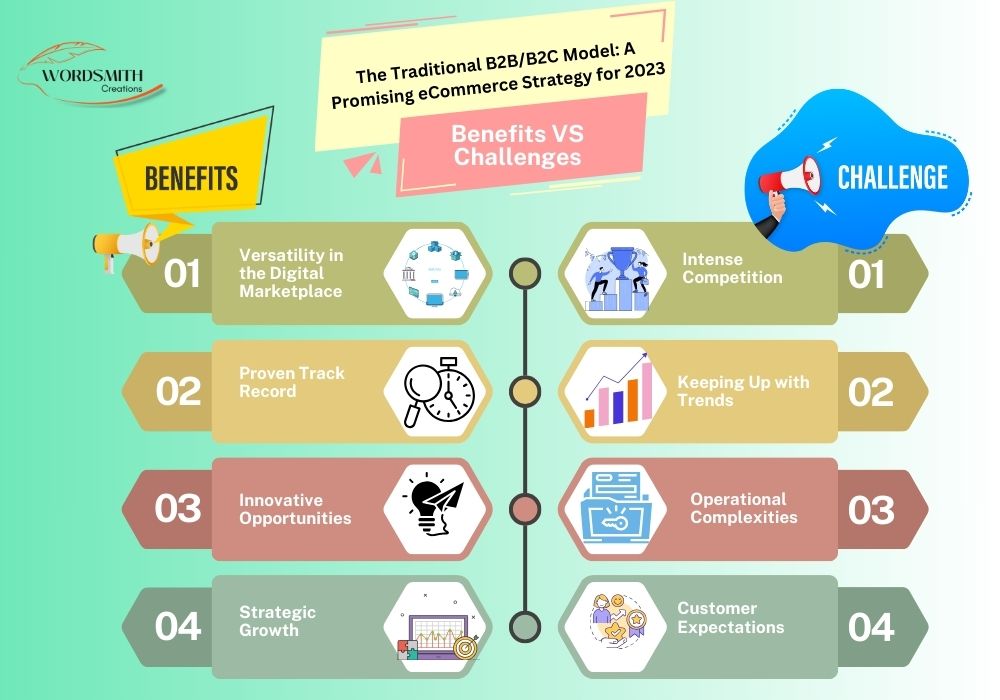
Introductions
In 2023, the digital marketplace is poised for unprecedented growth, with eCommerce platforms leading the charge. As online sales growth continues to surge, promising business models like dropshipping, subscription services, and direct-to-consumer strategies are emerging as top online business strategies. The future of online shopping is being shaped by innovative B2C strategies and the rise of the digital storefront. Among the most effective options for entrepreneurs are the best eCommerce model of 2023, which offer profitable online retail models and exciting digital business opportunities. With trends pointing towards a transformative year, those looking to start an eCommerce business in 2023 should stay abreast of emerging eCommerce trends and predictions to harness new ways to sell online successfully.
Popular eCommerce Business Models for 2023
As the digital marketplace continues to evolve, several promising eCommerce business model are emerging, setting the stage for the future of online shopping. Among the top online business strategies, eCommerce platforms remain at the forefront, offering a plethora of options for businesses to establish their digital storefront. Dropshipping, with its low overhead and flexibility, continues to be an effective model for those looking to venture into online retail without the hassle of inventory management.
Subscription services are gaining traction, providing consumers with curated experiences and consistent value. Direct-to-consumer models empower brands to interact directly with their audience, leveraging B2C strategies to enhance customer relationships. The rise of these models signifies a notable online sales growth, driven by innovations in the eCommerce sector.
2023 promises a shift towards more personalized and efficient retail strategies. The best eCommerce models for 2023 will focus on enhancing the online shopping experience, tapping into emerging eCommerce trends, and exploring new ways to sell online. For entrepreneurs wondering how to start an eCommerce business in 2023, the landscape is ripe with profitable online retail models and digital business opportunities. As we anticipate the eCommerce growth areas, it's evident that successful online store models will be those that prioritize customer-centricity, adaptability, and innovation.

The Traditional B2B/B2C Model: A Promising eCommerce Strategy for 2023
In the ever-evolving digital marketplace, the Traditional B2B/B2C Model stands out as one of the best eCommerce models for 2023. As online sales growth continues to surge, businesses are constantly seeking the most effective online shopping strategies to stay ahead of the curve. The B2B/B2C model, with its digital storefront, remains a cornerstone in the world of eCommerce, offering a blend of tried-and-true methods with emerging eCommerce trends.
Benefits:
- Versatility in the Digital Marketplace: Whether catering to businesses or direct-to-consumer, this model offers flexibility. Brands can leverage eCommerce platforms to tailor their offerings, ensuring they meet the diverse needs of their target audience.
- Proven Track Record: As one of the top online business strategies, the B2B/B2C model has a history of success. Its adaptability ensures it remains relevant, even as the future of online shopping continues to evolve.
- Innovative Opportunities: With the rise of eCommerce innovations, businesses can integrate new ways to sell online, enhancing the customer experience. From augmented reality features to AI-driven recommendations, the possibilities are endless.
- Strategic Growth: The model aligns well with B2C strategies, allowing businesses to tap into the ever-growing online retail market. As 2023 online shopping predictions indicate a continued upward trajectory, businesses using this model are well-positioned for success.
Challenges:
- Intense Competition: The digital business landscape is crowded. Brands must differentiate themselves, ensuring their eCommerce growth areas are unique and cater to specific customer needs.
- Keeping Up with Trends: The rapid pace of eCommerce innovations means businesses must stay updated. Whether it's adapting to new retail strategies or integrating the latest tech, staying relevant is crucial.
- Operational Complexities: Managing both B2B and B2C operations can be challenging. From inventory management to customer service, businesses must be equipped to handle the demands of both sectors.
- Customer Expectations: With the rise of direct-to-consumer brands and subscription services, customer expectations are higher than ever. Brands must ensure a seamless shopping experience, from browsing to checkout.
In conclusion, as we approach 2023, the Traditional B2B/B2C Model remains a promising option for businesses looking to capitalize on the digital marketplace's opportunities. By understanding its benefits and challenges, businesses can craft effective strategies, ensuring they're well-prepared for the future of eCommerce. Whether you're looking to start an eCommerce business in 2023 or seeking profitable online retail models, this model offers a solid foundation for success.
Dropshipping in 2023: A Promising eCommerce Business Model
In the ever-evolving landscape of online retail, the future of online shopping is being shaped by innovative eCommerce platforms and strategies. Among the most effective options for entrepreneurs looking to venture into the digital marketplace is dropshipping. As we approach 2023, dropshipping stands out as one of the best eCommerce models, offering a unique blend of flexibility and scalability.
Benefits of Dropshipping:
- Low Entry Barrier: Unlike traditional direct-to-consumer models, dropshipping eliminates the need for substantial upfront investment in inventory. This makes it one of the top online business strategies for newcomers.
- Digital Storefront Flexibility: Entrepreneurs can easily set up their digital storefront on various eCommerce platforms, tailoring their B2C strategies to meet the specific needs of their target audience.
- Adaptable to Trends: The dropshipping model allows businesses to quickly adapt to emerging eCommerce trends. Whether it's a sudden surge in demand for a particular product or a shift in consumer preferences, dropshippers can swiftly adjust their product offerings.
- Online Sales Growth Potential: With the right strategies, dropshippers can tap into the exponential online sales growth, capitalizing on the digital business opportunities that lie ahead.
- Subscription Services Integration: Dropshippers can also integrate subscription services into their model, offering customers the convenience of regular product deliveries, further enhancing the online shopping experience.
Challenges of Dropshipping:
- Competition: The ease of setting up a dropshipping business means that the digital marketplace is crowded. Differentiating one's brand and offerings becomes crucial to stand out.
- Inventory Management: While dropshippers don't hold inventory, they must ensure that their suppliers have stock. Integrating real-time inventory updates from suppliers can mitigate the risk of selling out-of-stock items.
- Reliance on Third Parties: Dropshippers depend on third-party suppliers for order fulfillment. Any delays or issues from the supplier's end can impact customer satisfaction.
- Profit Margins: Since dropshippers don't purchase in bulk, they might miss out on bulk purchase discounts, potentially leading to slimmer profit margins.
- Customer Service Challenges: Handling customer queries, returns, or complaints can be more complex, especially when the business doesn't have direct control over the products or shipping.
As we look ahead, the successful online store models will be those that effectively leverage the benefits of dropshipping while navigating its challenges. With the right approach, dropshipping can be a cornerstone of profitable online retail models. Entrepreneurs keen on exploring this model should stay informed about the 2023 online shopping predictions and be ready to adapt to new ways to sell online, ensuring their venture's success in the dynamic world of eCommerce.
Subscription Model in eCommerce: The Future of Online Retail in 2023
The digital marketplace has witnessed a plethora of promising business models, each tailored to meet the evolving demands of online shoppers. Among these, the Subscription Model stands out as one of the most effective strategies for eCommerce platforms in 2023. As the future of online shopping unfolds, let's delve into the benefits and challenges of this model, integrating insights from the top online business strategies and emerging eCommerce trends.
Benefits of the Subscription Model:
- Recurring Revenue Stream: One of the primary advantages of the subscription model is the steady flow of income. With consumers committing to regular payments, businesses can predict their online sales growth with greater accuracy.
- Tailored Customer Experience: Direct-to-consumer strategies allow businesses to curate personalized experiences. Subscription services offer a unique blend of products, often surprising the subscriber and enhancing their connection to the brand.
- Leveraging Digital Storefronts: The model seamlessly integrates with digital storefronts, ensuring a smooth user journey from browsing to purchasing. This synergy boosts the chances of converting a casual browser into a loyal subscriber.
- Tapping into eCommerce Innovations: Subscription models can easily incorporate the latest in eCommerce innovations, ensuring they remain at the forefront of the digital marketplace.
- Future-Proofing: With predictions pointing towards a continued rise in online shopping, subscription models are well-poised to capitalize on the future of online shopping trends.
Challenges of the Subscription Model:
- Customer Retention: While starting an eCommerce business with a subscription model might seem lucrative, retaining customers can be challenging. The digital business landscape is competitive, and brands need to consistently offer value to prevent churn.
- Managing Inventory: Unlike dropshipping, where inventory management is outsourced, subscription services often require businesses to predict demand accurately, ensuring they neither overstock nor run out of products.
- Navigating B2C Strategies: The direct-to-consumer approach, while beneficial, requires a deep understanding of consumer behavior. Brands must be adept at adjusting their strategies based on real-time feedback.
- Staying Updated: The rapid pace of eCommerce growth areas means businesses must continually update their offerings, ensuring they align with the latest online shopping predictions for 2023 and beyond.
- Differentiating from Competitors: With many new ways to sell online emerging, subscription services must find unique selling propositions to stand out in the crowded online retail space.
In conclusion, as we approach 2023, the Subscription Model emerges as one of the best eCommerce models. Its potential for profitability, combined with the challenges it presents, makes it a dynamic option for those looking to dive into the world of online retail. As digital business opportunities expand, those who can harness the power of successful online store models, like subscriptions, will undoubtedly lead the next wave of eCommerce evolution.
Which Model is Best for You? Navigating the eCommerce Landscape in 2023
The digital marketplace has witnessed a seismic shift in recent years, with online sales growth skyrocketing and the future of online shopping looking brighter than ever. As we approach 2023, the question on every entrepreneur's mind is: "Which eCommerce model should I adopt to stay ahead in this competitive landscape?" Let's explore the most compelling choices at our disposal.
1. Traditional eCommerce Platforms: These platforms remain a staple in the online retail world. They offer a comprehensive digital storefront where businesses can showcase a wide range of products. With the right B2C strategies, these platforms can be tailored to provide a unique direct-to-consumer experience, driving significant online sales growth.
2. Dropshipping: This model has gained traction for its low overhead costs and flexibility. By leveraging third-party suppliers, businesses can offer a diverse range of products without the need for inventory management. It's an effective way to tap into the digital marketplace without the challenges of stock and storage.
3. Subscription Services: The allure of recurring revenue has made subscription services a top online business strategy. From curated boxes to exclusive member benefits, this model capitalizes on customer loyalty and offers a fresh approach to online shopping.
Wordsmith Creations, a leading IT company, offers top-tier eCommerce services, ensuring that businesses are equipped with the tools and strategies they need to thrive in 2023 and beyond. From understanding the most profitable online retail models to predicting the next big thing in online shopping, Wordsmith Creations is at the forefront of the digital revolution.
In conclusion, as we approach 2023, the choices for online business models are vast. Whether it's dropshipping, subscription services, or a traditional B2C approach, the most successful models will be those that prioritize customer experience and adaptability. As the saying goes, "The best way to predict the future is to create it." So, dive into the world of eCommerce, explore the new ways to sell online, and carve a niche for your brand in the bustling digital marketplace.
Read More Blog: Educational Apps